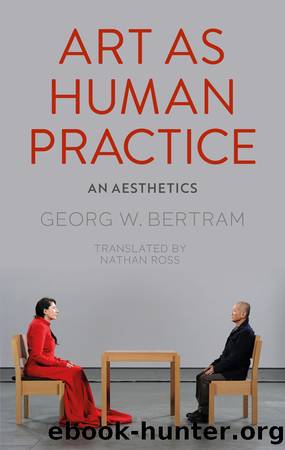Art As Human Practice by Georg W. Bertram

Author:Georg W. Bertram
Language: eng
Format: epub
Publisher: Bloomsbury UK
5.Interpretive activities in dealing with artworks
The dynamic structure of the artwork described up to now does not, however, simply exist on its own. This dynamic also is inherently made up of those practices that recipients develop in dealing with artworks. The structure of artworks is configured precisely in relation to these practices. Through their self-related constitution, they challenge forth the practices by which recipients respond to them. In order for this challenge to take effect, recipients have to enter into the artwork and confront themselves with the self-relational dynamic of the artwork. The self-relation of the artwork is in this sense to be taken as a moment within an interaction, as a moment within the interactive relation that constitutes it. The artwork demands to be reenacted, and in its dynamic it is constitutively bound up with this reenactment. It demands practices by which recipients articulate the structures of the artwork.
The challenge issued by artworks thus has the character of being essentially practical: for example, when a recipient follows the relations within a picture with her gaze, this leads to specific pathways of gazing that are oriented toward the self-referentially established relations within the artwork.28 The activities of the recipient develop by being guided by these relations. To this degree we can say that artworks demand a certain behavior. Employing another one of the central concepts from Adornoâs Aesthetic Theory, we can characterize this behavior as mimetic.29 A behavior is mimetic when it appropriates things in a differentiated manner. We would understand such a mimetic behavior falsely if we think of it mainly as passive (as Adorno sometimes suggests).30 Recipients have to be active in order to be guided, so that aesthetic practices always have two sides: On the one hand, these practices reflect a dynamic that gets its impetus from the artwork by following it, but on the other hand, these practices also involve the recipient in new activities, and thus new approaches and interventions. Gadamer captures this by writing that the recipient always has to be a fellow player (Mitspieler): They have to receive the ball that is passed to them and pass it back.31
Recipients are always just as productive as producers in their dealings with artworks because of how their own activities develop. Artworks that do not stir some activity cannot unfold any effect. This is especially true of artworks that are unfamiliar to the recipients. Let us take the example of a painting that is new for someone contemplating it. In such a case, this person will have to cultivate her visual activities further. If she does not become active in her seeing, she will not be able to follow the painting. This activity always consists in the recipient developing her own impulses in dealing with the artwork, for example, by choosing a specific starting point, or bringing up conflicting points within the constellation of the work, or comparing the work to established ways of dealing with it. Our own impulses also have a special relevance, since we use them to act within the framework of a history of receptions.
Download
This site does not store any files on its server. We only index and link to content provided by other sites. Please contact the content providers to delete copyright contents if any and email us, we'll remove relevant links or contents immediately.
The Japanese by Christopher Harding(1058)
Watercolor With Me in the Forest by Dana Fox(739)
A Theory of Narrative Drawing by Simon Grennan(727)
The Story of the Scrolls by The Story of the Scrolls; the M(716)
Glittering Images: A Journey Through Art From Egypt to Star Wars by Camille Paglia(677)
Boris Johnson by Tom Bower(612)
This Is Modern Art by Kevin Coval(583)
The Art and Science of Drawing by Brent Eviston(578)
Frida Kahlo by Frida Kahlo & Hayden Herrera(572)
AP Art History by John B. Nici(561)
Banksy by Will Ellsworth-Jones(556)
War Paint by Woodhead Lindy(538)
Van Gogh by Gregory White Smith(537)
Scenes From a Revolution by Mark Harris(531)
Draw More Furries by Jared Hodges(529)
Ecstasy by Eisner.;(525)
About Looking by John Berger(525)
100 Greatest Country Artists by Hal Leonard Corp(512)
Young Rembrandt: A Biography by Onno Blom(504)
